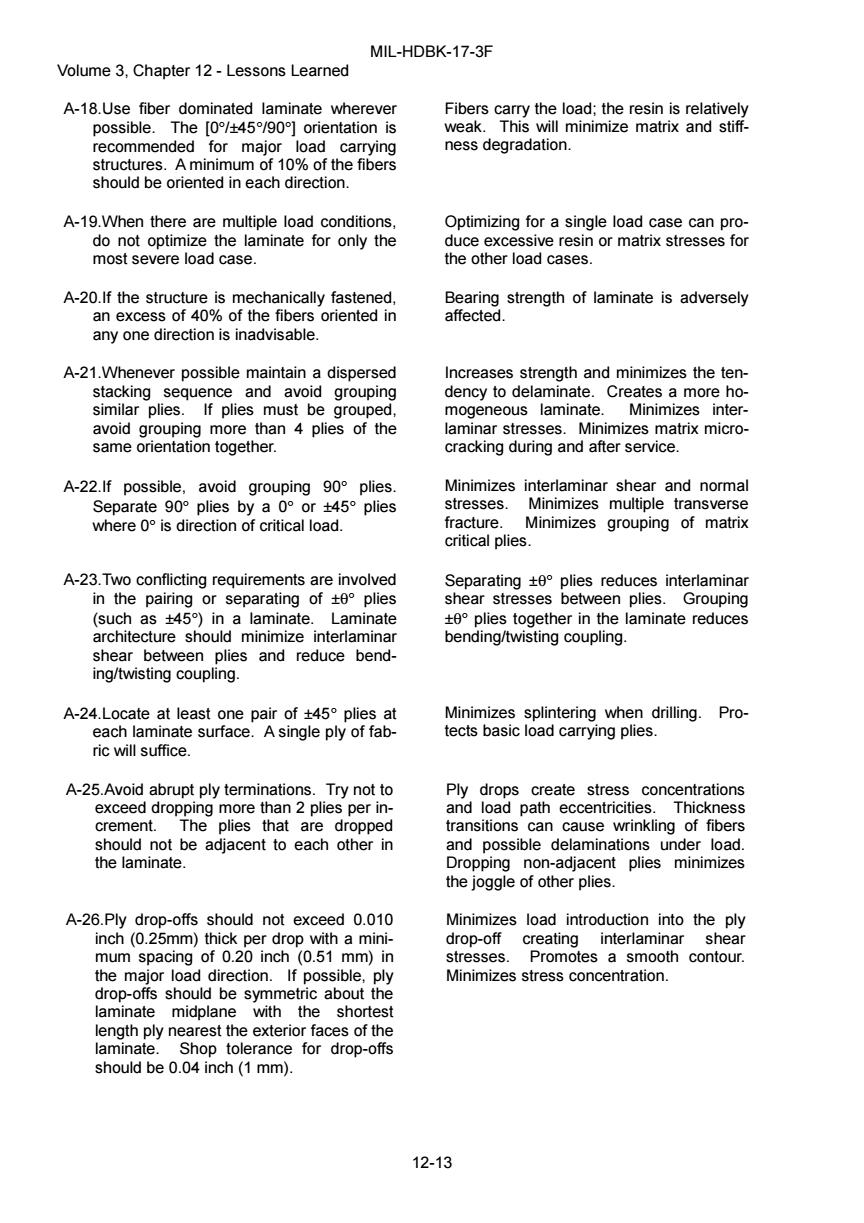正在加载图片...

MIL-HDBK-17-3F Volume 3,Chapter 12-Lessons Learned A-18.Use fiber dominated laminate wherever Fibers carry the load:the resin is relatively possible.The [0/+45/90]orientation is weak.This will minimize matrix and stiff- recommended for major load carrying ness degradation. structures.A minimum of 10%of the fibers should be oriented in each direction. A-19.When there are multiple load conditions, Optimizing for a single load case can pro- do not optimize the laminate for only the duce excessive resin or matrix stresses for most severe load case. the other load cases A-20.If the structure is mechanically fastened, Bearing strength of laminate is adversely an excess of 40%of the fibers oriented in affected. any one direction is inadvisable. A-21.Whenever possible maintain a dispersed Increases strength and minimizes the ten- stacking sequence and avoid grouping dency to delaminate.Creates a more ho- similar plies.If plies must be grouped, mogeneous laminate.Minimizes inter- avoid grouping more than 4 plies of the laminar stresses.Minimizes matrix micro- same orientation together. cracking during and after service. A-22.If possible,avoid grouping 90 plies. Minimizes interlaminar shear and normal Separate90°plies by a0°ort45°plies stresses. Minimizes multiple transverse where 0 is direction of critical load. fracture.Minimizes grouping of matrix critical plies. A-23.Two conflicting requirements are involved Separating t0 plies reduces interlaminar in the pairing or separating of tθ°plies shear stresses between plies.Grouping (such as t45)in a laminate.Laminate t0 plies together in the laminate reduces architecture should minimize interlaminar bending/twisting coupling. shear between plies and reduce bend- ing/twisting coupling. A-24.Locate at least one pair of t45 plies at Minimizes splintering when drilling.Pro- each laminate surface.A single ply of fab- tects basic load carrying plies. ric will suffice. A-25.Avoid abrupt ply terminations.Try not to Ply drops create stress concentrations exceed dropping more than 2 plies per in- and load path eccentricities.Thickness crement.The plies that are dropped transitions can cause wrinkling of fibers should not be adjacent to each other in and possible delaminations under load. the laminate. Dropping non-adjacent plies minimizes the joggle of other plies. A-26.Ply drop-offs should not exceed 0.010 Minimizes load introduction into the ply inch(0.25mm)thick per drop with a mini- drop-off creating interlaminar shear mum spacing of 0.20 inch (0.51 mm)in stresses.Promotes a smooth contour. the major load direction.If possible,ply Minimizes stress concentration. drop-offs should be symmetric about the laminate midplane with the shortest length ply nearest the exterior faces of the laminate.Shop tolerance for drop-offs should be 0.04 inch(1 mm). 12-13MIL-HDBK-17-3F Volume 3, Chapter 12 - Lessons Learned 12-13 A-18.Use fiber dominated laminate wherever possible. The [0°/±45°/90°] orientation is recommended for major load carrying structures. A minimum of 10% of the fibers should be oriented in each direction. Fibers carry the load; the resin is relatively weak. This will minimize matrix and stiffness degradation. A-19.When there are multiple load conditions, do not optimize the laminate for only the most severe load case. Optimizing for a single load case can produce excessive resin or matrix stresses for the other load cases. A-20.If the structure is mechanically fastened, an excess of 40% of the fibers oriented in any one direction is inadvisable. Bearing strength of laminate is adversely affected. A-21.Whenever possible maintain a dispersed stacking sequence and avoid grouping similar plies. If plies must be grouped, avoid grouping more than 4 plies of the same orientation together. Increases strength and minimizes the tendency to delaminate. Creates a more homogeneous laminate. Minimizes interlaminar stresses. Minimizes matrix microcracking during and after service. A-22.If possible, avoid grouping 90° plies. Separate 90° plies by a 0° or ±45° plies where 0° is direction of critical load. Minimizes interlaminar shear and normal stresses. Minimizes multiple transverse fracture. Minimizes grouping of matrix critical plies. A-23.Two conflicting requirements are involved in the pairing or separating of ±θ° plies (such as ±45°) in a laminate. Laminate architecture should minimize interlaminar shear between plies and reduce bending/twisting coupling. Separating ±θ° plies reduces interlaminar shear stresses between plies. Grouping ±θ° plies together in the laminate reduces bending/twisting coupling. A-24.Locate at least one pair of ±45° plies at each laminate surface. A single ply of fabric will suffice. Minimizes splintering when drilling. Protects basic load carrying plies. A-25.Avoid abrupt ply terminations. Try not to exceed dropping more than 2 plies per increment. The plies that are dropped should not be adjacent to each other in the laminate. Ply drops create stress concentrations and load path eccentricities. Thickness transitions can cause wrinkling of fibers and possible delaminations under load. Dropping non-adjacent plies minimizes the joggle of other plies. A-26.Ply drop-offs should not exceed 0.010 inch (0.25mm) thick per drop with a minimum spacing of 0.20 inch (0.51 mm) in the major load direction. If possible, ply drop-offs should be symmetric about the laminate midplane with the shortest length ply nearest the exterior faces of the laminate. Shop tolerance for drop-offs should be 0.04 inch (1 mm). Minimizes load introduction into the ply drop-off creating interlaminar shear stresses. Promotes a smooth contour. Minimizes stress concentration